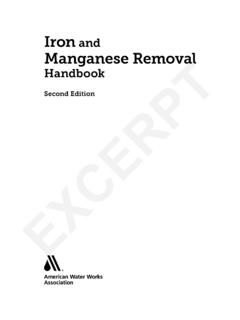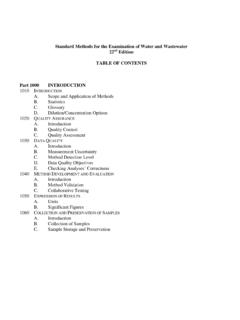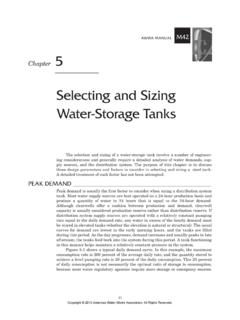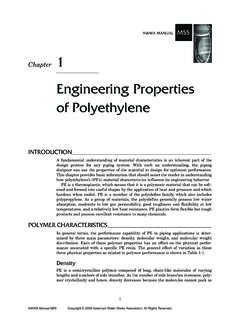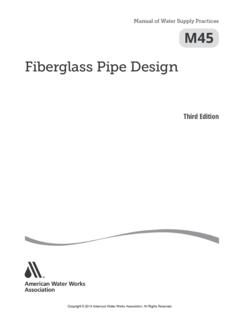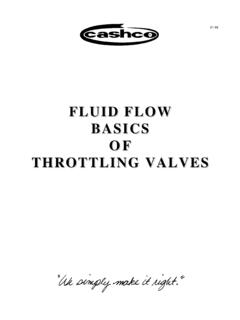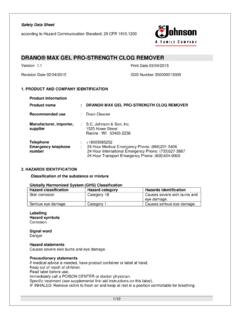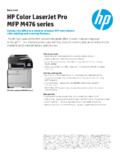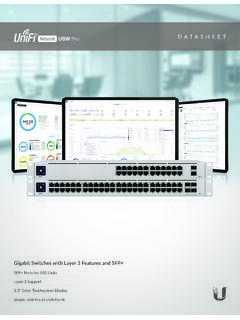Transcription of Distribution System Requirements for Fire Protection
1 Distribution System Requirements for fire ProtectionAWWA MANUAL M31 Fourth EditionCopyright 2008 American Water Works Association. All Rights of Figures, vList of Tables, viiPreface, ixAcknowledgments, xiChapter 1 fire Flow Requirements ..1 Impact on Distribution System Design, 1 Community Governance, 2 fire Flow Requirements , 2 Calculating fire Flow Requirements , 2 Practical Limits on fire Flow, 13 Nonpotable Water Sources for fire Fighting, 15 References, 16 Chapter 2 System Demand and Design Flow Criteria .. 17 Methods of Distribution , 17 Rates of Water Use, 18 Distribution System Appurtenances, 19 System Evaluation and Design, 21 Determining Design Flow, 21 Flow Metering, 22 Standby Charges for fire Protection Systems, 22 Water Distribution Analysis Techniques, 22 References, 23 Chapter 3 Distribution System Storage ..25 Functions of Distribution Storage, 25 Elevated and Ground Storage, 27 Pumping for Distribution Storage, 28 Location of Storage, 28 Storage Reservoir Overflow Level, 28 References, 30 Chapter 4 Adequacy and Reliability of Distribution Systems.
2 31 Determining Level of Reliability, 31 Application of Reliability Considerations, 33 Reliability of Major System Components, 34 Operations, 36 References, 37iiiCopyright 2008 American Water Works Association. All Rights 5 Automatic fire Sprinkler Systems .. 39 Advantages of Sprinkler Systems, 39 Water Supply Requirements for Sprinklered Properties, 40 Types of Sprinklers for Commercial Buildings, 42 Standpipes, 43 Backflow Prevention for fire Sprinkler Systems, 43 References, 45 Appendix A Agencies Involved in fire Protection .. 47 Insurance Services Office Inc., 47 Insurance Organizations With fire Protection Interests, 48 National fire Protection Association, 48 National fire Service Associations, 48 fire Research Laboratories, 48 National fire Sprinkler Association, 48 American fire Sprinkler Association, 49 International Code Council, 49 Insurance Bureau of Canada, 49 Insurers Advisory Organization, 49 National Research Council, 49 Underwriters Laboratories of Canada, 49 Appendix B Water Supply and fire Insurance Ratings.
3 51 Insurance Ratings, 51 References, 54 Index .. 55 List of AWWA Manuals ..59ivCopyright 2008 American Water Works Association. All Rights MANUALM31 Chapter1 fire Flow RequirementsFor centuries, water has been used to extinguish fires. The inexpensiveness and availability of water are the primary factors leading to its widespread use. But, not only must water be available for fire Protection , it must be available in adequate supply. As a result, the question must be asked, how much water is necessary to be considered an adequate supply for fire Protection ? (Milke 1980)Most municipalities are willing to incur the higher cost for Distribution System sizing because of the reduction in loss that is possible by using the water System for fire Protection . Water in sufficient quantity can cool the fire ; the steam can deprive the fire of oxygen, and in the case of miscible or dense fluids, water can disperse the fuel. The key question for water utilities is how large must Distribution System components be to provide sufficient water for fire Protection .
4 The remainder of this manual presents methods for estimating these ON Distribution System DESIGN _____The decision to provide water for fire Protection means that a utility must explicitly consider fire flow Requirements in sizing pipes, pumps, and storage tanks. In larger systems, fire Protection has a marginal effect on sizing decisions, but in smaller sys-tems these Requirements can correspond to a significant increase in the size of many compo nents. In general, the impact of providing water for fire Protection ranges from being minimal in large components of major urban systems to being very significant in smaller Distribution System pipes and small Distribution systems. The most significant impacts are installing and maintaining fire hydrants, pro-viding adequate storage capacity, and meeting Requirements for minimum pipe sizes ( , 6-in. [150-mm] pipes in loops and 8-in. [200-mm] dead ends) in neighborhood Distribution mains when much smaller pipes would suffice for delivery of potable water only.
5 These Requirements make designing Distribution systems easier for the engineer but more costly for the water utility. Other impacts include providing extra treatment capacity at plants and extra pumping capacity at pump 2008 American Water Works Association. All Rights fire PrOTeCTIONCOMMUNITY GOVERNANCE _____The decision of whether or not to size Distribution System components, including water lines, appurtenances, and storage facilities, for fire Protection must be made by the governing body of the community. This decision is made in conjunction with the water utility if the utility is privately owned. However, there is no legal requirement that a governing body must size its water Distribution System to provide fire Protection . In some instances, this undertaking may be prohibitively expensive. For privately owned utilities, the Distribution System would not be sized for fire Protection unless such an undertaking could be shown to be commercially governing bodies of most communities do provide water for fire Protection for a variety of reasons, including Protection of the tax base from destruction by fire , preservation of jobs that would be lost in the event of a large fire , preservation of human life, and reduction of human a community s governing body provides fire Protection , it must do so in accordance with a well-thought-out plan that will provide adequate supplies for the in-tended purpose.
6 An inadequate fire Protection System provides a false sense of security and is potentially more dangerous than no System at FLOW Requirements _____When establishing a fire Protection plan, the governing body must first select a well-documented procedure for determining the fire flow requirement. Central to provid-ing enough water is a determination of how much water should be made available for any given situation. The following definition of required fire flow will be used in this manual: the rate of water flow, at a residual pressure of 20 psi (138 kPa) and for a specified duration, that is necessary to control a major fire in a specific structure. A complete definition of required fire flow requires a determination of both the rate of flow required and the total amount of water that must be applied to control the fire . The rate of flow and the duration of flow required may be specified by the simple equation: quantity = rate duration (Eq.)
7 1-1)Understanding Water UseThe importance of flow rate and total quantity must be realized when attempting to understand the ways in which water is used to suppress fire . Water applied to a fire ac-complishes two things. First, it removes the heat produced by the fire , thereby prevent-ing that heat from raising the temperature of unignited material to the ignition point. Water absorbs the heat of the fire when it changes from a liquid to a gaseous state as the heat is released as steam. Second, water not converted to steam by the heat of the fire is available to cool material not yet ignited. Water also blankets unignited mate-rial, excluding the oxygen required to initiate and sustain fire FLOW Requirements _____All fires are basically different because of random variations in the structure and con tents of the burning building, exposures (configuration of adjacent structures not involved in a fire but that are to be protected to prevent the fire from spreading), weather, temperature, and length of time the fire has been burning.
8 Consequently, numerous methods have been proposed for determining how much water is enough to suppress a fire . The following sections describe four methods for calculating fire flow Requirements . These methods have been developed by the Insurance Services Office Copyright 2008 American Water Works Association. All Rights FlOW Requirements 3 Inc. (ISO),* Iowa State University (ISU), the National fire Academy, and the Illinois Institute of Technology Research Institute (IITRI). Responsibility for determining needed fire flows for individual structures usually rests with the local fire officials based on information provided by the owner. Rating services such as ISO may determine this flow during an evaluation for insurance pur-poses. For planning purposes, water departments may determine representative fire flow Requirements in portions of towns for System planning, hydraulic analysis, and Durations Recommended fire flow durations to be used in the four methods are given in Table 1-1.
9 The maximum required fire flow for a single fire event is 12,000 gpm (757 L/sec).Insurance Services Office MethodThe ISO s technique for calculating required fire flow is documented in its publica tion fire Suppression Rating Schedule. The term used in that document to describe the fire flow requirement is needed fire flow (NFF).Needed fire flow (NFF) . The NFF is the rate of flow considered necessary to control a major fire in a specific building for a certain duration. It is intended to as-sess the adequacy of a water System as one element of an insurance rating schedule. It is not intended to be a design criterion. However, it has been demonstrated that the NFF reasonably coincides with the actual flow required to suppress a fire in a real-life water supply should be capable of providing the maximum NFF within its dis-tribution System area. In designing a new water Distribution System or improvements within an existing Distribution System , it is customary to provide for the NFF within the design area.
10 However, it is very unusual for an existing water Distribution System to be capable of providing every NFF within its service ISO classification of a community s water System is based on the available rates of flow at representative locations, with an NFF of 3,500 gpm (221 L/sec), or less, as determined by the application of its fire Suppression Rating Schedule. Private and public Protection at properties with larger NFFs is individually evaluated and may vary from the community s 1-1 fire flow durationsRequired fire FlowDurationgpm(L/sec)hr2,500 or less(158 or less)23,000 to 3,500(189 to 221)3* Insurance Services Office Inc., 545 Washington Blvd., Jersey City, NJ 07310-1686. Iowa State University, fire Extension Service, Ames, IA 50011. US fire Administration, 16825 S. Seton Ave., Emmitsburg, MD 21727. Illinois Institute of Technology Research Institute, 10 W. 35th St., Chicago, IL 60616. fire flow durations are based on the 19th edition of the National fire Protection Associa-tion s fire Protection Handbook, table 2008 American Water Works Association.

